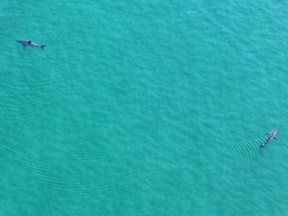Nova Scotia’s coastal waters are feeling a tad sharkey of late, with an estimated 400 great whites making their way to Canada’s ocean playground each summer
Article content
Just one day after spotting a great white shark during his regular morning row in Halifax’s Northwest Arm, Jeff Kirby returned to the inlet that connects to the Atlantic Ocean to try his luck again.
Kirby, 72, displayed a touch of gallows humour when asked if he was at all worried about sharks before pushing his single off the dock just after dawn Wednesday and sculling away on the calm water of the city’s popular saltwater swimming and boating destination.
Advertisement 2
Article content
“I’m obsessed (with rowing) and you gotta go somehow,” the retired Dalhousie University medical ethics professor said in a text.
In an interview dockside, just before he rowed out to sea, Kirby described spotting a 12-foot shark Tuesday come right out of the water in a stretch of normally tranquil ocean between the Atlantic School of Theology and the Royal Nova Scotia Yacht Squadron. The shore is lined with mansions of the rich and Halifamous, but public access points abound, where sunbathers loll on hot days, and dog owners toss balls into the ocean with abandon.
“All of a sudden – you’re looking backward when you’re rowing – I could see clearly something huge left the water and it lunged forward,” he said.
“It actually breached; it was fully out of the water.”
After talking to an expert, Kirby is sure it was a juvenile white shark.
Shark sightings aren’t the rarity they once were around Nova Scotia. Locals recently freed a tangled great white in Port Medway; a duck hunter lost his dog last year to a shark attack in the same area; the location of tagged sharks is a reoccurring topic of conversation; warning signs have gone up at some beaches; and boaters are reporting the toothy beasts with an alarming regularity.
Advertisement 3
Article content
Nova Scotia’s coastal waters are feeling a tad sharkey of late, with an estimated 400 great whites making their way to Canada’s ocean playground each summer.
“Everybody is seeing them more,” said Aaron MacNeil, a marine biologist at Dalhousie.
“And that has to do with people being on the water and taking videos and seeing videos that other people take on the water. So, there’s just more seeing going on for sure. Are there more of them around inshore? It’s a little harder to say.”
Recommended from Editorial
But more sharks are inevitable, he said, as Nova Scotia’s waters warm sooner and cool off later than in previous years.
“They’ve been protected now for more than 30 years from fishing,” MacNeil said. “And the other thing is the population of coastal seals (they like to eat) in Nova Scotia is slowly increasing.”
When Kirby sculls out past the rocks dubbed Hens and Chickens at the southern tip of Point Pleasant Park, he knows they’re likely to be full of seals basking in the sun.
“I start to the hear the Jaws music and turn around,” Kirby said.
Article content
Advertisement 4
Article content
People swim regularly from pebbled beaches and piers that dot both sides of the Arm, but MacNeil doubts the great white that surfaced Tuesday is still hanging around.
“White sharks don’t loiter,” he said. “They move constantly up and down the coast looking for things to eat.”
He’s been rowing on the Arm for nearly a decade, often spotting porpoises and the occasional minke whale. But Tuesday marked Kirby’s first close encounter with a shark, which he described as popping up about half a city block from his narrow, tippy craft.
White shark numbers were “severely depressed” for many years, said Fred Whoriskey, executive director of the Ocean Tracking Network, a global aquatic research, data management and partnership platform headquartered at Dalhousie University.
“It probably got knocked down by by-catch in ongoing fisheries that were out there,” Whoriskey said. “And it’s a long-life species with a really slow reproductive rate, so when you take them out, they don’t replace themselves very fast.”
Conservation measures implemented in both Canada and the United States have changed that, he said. “What we’re seeing now, in my opinion, is an upsurge.”
Advertisement 5
Article content
A lot of the white sharks working their way into Canadian waters are juveniles, which is “characteristic of a population that’s growing,” he said.
And when those become adults, their menu choices change.
“The younger ones are fish-eaters and then they undergo a kind of metamorphosis, and the teeth structure actually changes,” Whoriskey said.
“The teeth change from more nail-like piercing and spearing teeth, which you use to catch fish, to serrated-edged triangular teeth like you see in the Jaws movies and like you would have on a steak knife. It makes them capable of taking on marine mammals as a prey.”
That change happens when white sharks reach the length of between seven and 10 feet, somewhere between the age of six and 10 years old.
“It takes a while,” Whoriskey said, noting white sharks can live as long as 60 years.
But they don’t all make it to that age.
“The ocean’s a cruel place and even white sharks have things that eat them,” Whoriskey said, noting killer whales and larger sharks will prey on them.
A population estimate for Cape Cod pegged the white shark population there at about 800, he said.
Advertisement 6
Article content
“About 30 per cent of them stayed all spring, summer, autumn, then they would head south to warm up for the winter, and 70 per cent moved on to other places.”
Between 250 and 300 of those white sharks have been tagged with devices that can be detected by a network of as many as 2,000 receivers off the coast of Nova Scotia.
“And there are probably many more because we know that we don’t have all of the sharks tagged. We have no idea what fraction, truly, of the Northwest Atlantic population we’ve got tagged,” Whoriskey said.
Commercial fishermen concerned with the “explosion of seals in the Northwest Atlantic” and how they’re gobbling up fish should be relieved to see the return of white sharks, he said.
“One of the surest ways to deal with the potential predation of grey seals on cod is to have something that’s out there eating the seals,” Whoriskey said.
“Sharks eat seals. That’s their bread and butter, so to speak. It’s a nice, big, fat, lots-of-calories meal for them, and that’s what they’re after.”
Societal objections to hunting seals – think Brigitte Bardot on an ice floe — have allowed their population to grow.
Advertisement 7
Article content
Whoriskey expects the white shark population off Nova Scotia to continue climbing. “Where it’s going to peak, we don’t know yet. In the predator/prey game, there’s always a tug between the two sides of the equation. So, as the predators grow, the seals are going to adopt new strategies to try to avoid getting eaten by sharks.”
Seals will fight back when attacked, he said. “And they are formidable. They’re strong and they’ve got big, sharp teeth.”
Whoriskey’s telemetry work with sharks shows they’re staying inshore.
“Where we’re finding fairly large concentrations are offshore islands relatively close to the mainland (such as the LaHave Islands just west of Lunenburg) where you have a deep channel which leads up to an area on land where the seals are hauling out. The seals haul out on those islands because there aren’t people around that are harassing them all the time and they feel safe.”
Whoriskey is pushing the message that the ocean is home to white sharks.
“They are not hunting humans, because we would have a whole lot more impacts on humans if they were,” he said. “We’ve not had a fatal attack in Canada through a direct attack on a person since the mid-1800s.”
Advertisement 8
Article content
A shark dubbed the Forchu Rammer sank a dorey, drowning the man at the oars, in the 1950s, Whoriskey said. “And then there was a fatal attack in Maine about five years ago of an offshore swimmer swimming between islands in a hunting ground for the sharks, where seals were hauling out. So, it’s probably a case where sharks thought they were attacking a seal at the time.”
Still, it’s difficult for many to get over the visceral terror sharks prompt.
“It is a fearsome animal,” Whoriskey said. “We’ve had that media cult of Jaws that has instilled a fear that is quite phenomenal. When Jaws first came out, I was in the middle of the Sonoran Desert in Arizona and people were scared to go to the washroom because they thought sharks might come up out of the tubes sort of thing. So, it just got into the psychology of everybody.”
While a white shark bit a young woman who jumped off a boat near Cape Breton’s Margaree Island in August of 2021, MacNeil said the risk of humans being attacked are minute.
“That’s the only person that’s ever been attacked by a shark in the Atlantic provinces, and she survived,” MacNeil said. “From what fishermen have told me, she happened to be swimming amongst a bunch of seals.”
Advertisement 9
Article content
The best analogy for Canadians would be to compare it to the risk posed by grizzly bears, he said. “If you’ve ever been in the woods in B.C., in bear country, then you’re taking on a similar level of risk to going in the water in Nova Scotia.”
Avoid swimming at night, as well as dawn and dusk if possible, experts advise.
“Most sharks are crepuscular, meaning they do a lot of predation in between the lightest part of the day and the darkest part of the night,” MacNeil said. “Most sharks are most active at that time.”
But that rule might not apply to white sharks, he said, noting they do a lot of hunting in the daytime.
“You’re talking about a risk that’s so low it’s like winning the lottery in a bad way,” MacNeil said.
“People can be smart and pay attention to their surroundings. If they suddenly get a wigged-out feeling, then just get out of the water for a while.”

Halifax eye surgeon Alex de Saint Sardos has taken to using a drone to check for sharks before his family heads out on the water from their cottage in Green Bay, on the province’s South Shore.
“I’ve ruined everybody’s swimming plans,” he said with a chuckle.
Advertisement 10
Article content
De Saint Sardos has been looking for great whites from the air for about four years. Some summers have produced thin results, despite regular drone flights.
“But then this summer I found sharks every day for six weeks straight,” he said. “They were all great whites.”
Green Bay’s sandy bottom makes sharks easy to spot and follow from his Boston Whaler.
“We would go out with the boat and the kids, and we would go up to the sharks and that was kind of fun,” de Saint Sardos said. “At dusk, when it’s a little calmer, you can see the fins on the surface.”
While his family is “more cautious and conscientious” about the presence of sharks, de Saint Sardos notes he’s seen lots of drone videos from Florida and California showing sharks amongst surfers not bothering them in the least.
But when he drops his board while kite surfing, de Saint Sardos beelines it back to shore and waits for it to blow back in.
“When you drop your board, you go back and forth and back and forth – it’s called body dragging,” he said. “I don’t love the idea of doing that when I know that there’s sharks nearby.”
Our website is the place for the latest breaking news, exclusive scoops, longreads and provocative commentary. Please bookmark nationalpost.com and sign up for our daily newsletter, Posted, here.
Article content








